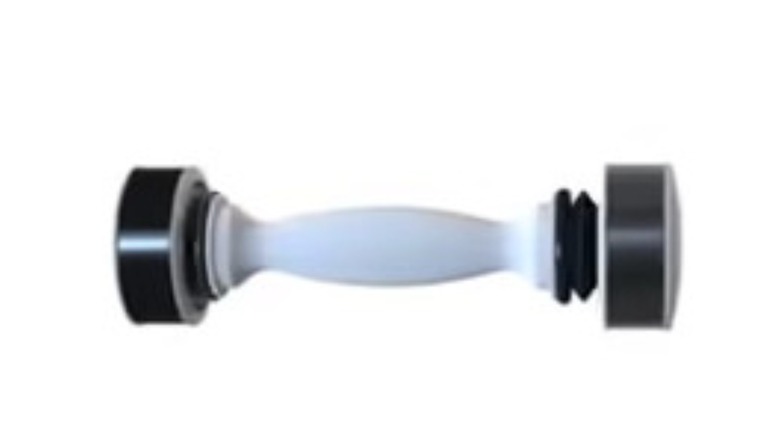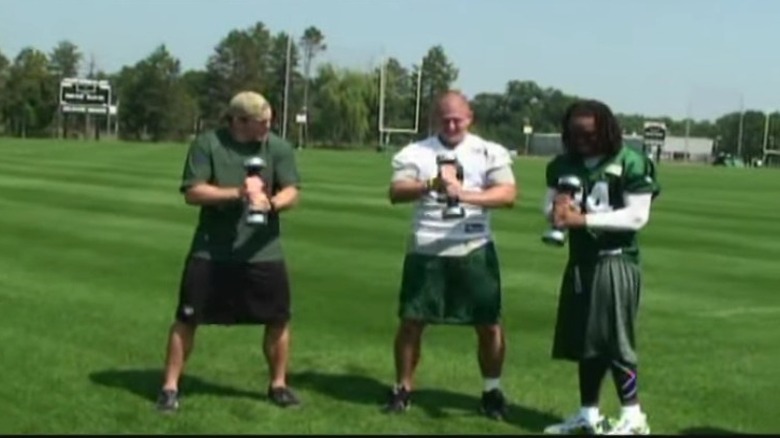What Happened To The Shake Weight?
An ongoing trend in the world of health and exercise is fitness products introduced to the public via eye-catching, often over-the-top television advertisements — Tae Bo, the Ab Roller, the ThighMaster, and of course, the unforgettable Shake Weight. Per a 2010 interview with Inc., Shake Weight inventor and CEO of Fitness IQ Johann Verheem was inspired to unveil a product for women that targeted the upper arms after then-first lady Michelle Obama became a fitness and fashion icon. Obama was and continues to be known for her extremely toned, muscular arms that she often showcases with sleeveless sheaths.
Inspired by the concept of dynamic inertia, the Shake Weight is shaped like a traditional dumbbell, with weights on either end that attach to the handle with a spring. In his interview with Inc., Verheem said he developed the product with a Taiwanese design group "and had it patented and prototyped, and then it sat around for a year. Ironically, we were just not sure you could sell a dumbbell on TV."
Michelle Obama inspired the introduction of the Shake Weight
When Johann Verheem noticed that Michelle Obama's arms had become aspirational among American women, he realized it was the perfect time to introduce the Shake Weight to the public. When Inc. asked Verheem why his creation had taken off and brought in such high sales numbers, he explained, "There's not another great product out there already that specifically works women's biceps. Women don't like heavy gym equipment that's designed for men to bulk up — most of the weight products on the market are designed for weightlifting."
Per his Inc. interview, Verheem's original release of the product started modestly one weekend, "spending $10,000 to $20,000 on ads and treating it as a focus group." He said the results were "okay, but nothing special," but as soon as comedians and talk show hosts became aware of the Shake Weight and how it worked, things changed very quickly. The arm motion needed to exercise with the Shake Weight implied a rather suggestive act, which made it ripe for parody and jokes.
Plenty of jokes and free publicity
Rather than getting upset over the Shake Weight becoming a nationwide joke, Johann Verheem told Inc. that he embraced the free publicity. "Jimmy Kimmel Live!" and "The View" both featured the product soon after its release, and the Shake Weight mania took off from there. Per Verheem, "By Friday, we had millions of hits on the video, and people were making fun of it. Then 'Ellen' picked it up and featured it on several different programs. I mean, that was amazing, because even though it comes with a laugh, the product placement for those three minutes of air-time would have cost us millions to buy." The Shake Weight for Men soon followed, and Verheem employed Navy SEALs and Army Rangers to demonstrate the product in commercials and emphasize the toughness of the workout (as opposed to the standard Shake Weight that was intended to be a toning product for women).
Regarding the suggestiveness inherent in the weight shaking, Verheem told Inc. that it wasn't intentional: "We never intended for the women's device ad to have innuendo," he said. "We had a bunch of people here from the industry, and a lot of women on the set, and they didn't make many comments. But it depends how you shake it as well. If you do it based on the three exercises that we have laid out, it's not that suggestive."
Even professional football players tried out the Shake Weight
Less than a year after the Shake Weight's release, between the 2.5-pound original and 5-pound Shake Weight For Men, people bought over 2 million of them at $19.95 apiece, bringing in a total of $40 million for Fitness IQ (via CNBC). The product's notoriety continued to bring in free publicity – the New York Jets football team notably bought 100 Shake Weights and used them for the HBO program "Hard Knocks," using the weights at team practice for a total of one minute and 15 seconds (the Shake Weight was mentioned seven times). Per Eric Wright of the sponsorship evaluation firm Joyce Julius, this was worth $224,750 in advertising time. The parodies that followed on "Saturday Night Live" and "South Park"? Priceless.
When the initial hype wore off, and it was clear that a huge number of people had bought the Shake Weight and presumably wanted to tone their arms on top of having a laugh, many wondered whether or not the novelty item's claims of being a revolutionary new way to work the arms, chest, and shoulders had any sort of merit.
Did Shake Weights actually provide a good workout?
Does the Shake Weight actually work well when it comes to building and toning muscles? In October 2010, NBC News reporter Diane Mapes spent four weeks doing the six-minute-long workout that came on DVD with the Shake Weight and reported on her experience. Mapes admitted that using the product "just look[ed] nasty" but noted that once she got past the suggestiveness inherent to the workout's moves, she "did feel the burn. In my biceps, my triceps, my shoulders — and, the one time I forgot to close the blinds and saw a neighbor peering in at me — in my face."
Consumer Reports performed a more scientific study in which researchers attached electrodes to people exercising with Shake Weighs to measure muscle activity and determine the effectiveness of the exercises. The subjects then compared the muscle activity involved when exercising with Shake Weights to the muscle activity during more traditional arm exercises, including modified push-ups and using elastic resistance bands. The study concluded that there was no more muscle activity measured during Shake Weight exercises than during the more traditional arm exercises, and in most cases, the traditional exercises actually generated more activity.
No gains, possible pain?
WebMD reached similar conclusions, noting that the Shake Weight is actually more dangerous than traditional exercises because the traditional exercises provide the opportunity for exercisers to target muscles through a full range of motion. Conversely, the shaking motion required by the Shake Weight can actually cause muscle spasms that might lead to injury.
Like most trends, the Shake Weight was suddenly everywhere for a short period of time, and then it disappeared from the public view and conversation as quickly as it arrived. In 2013, Runner's World Newswire (via Yahoo!) noted that the Journal of Sports Science and Medicine performed a study in which 25 young people did three different exercises from the Shake Weight routine – the chest shake, biceps shake, and triceps shake — first using the Shake Weight and then traditional dumbbells, all while researchers measured muscle activity in areas targeted by the exercises. Like Consumer Reports, the journal found that Shake Weights were no more effective than traditional weights. Per Yahoo!, researchers also found that "no muscle group during any of the [Shake Weight] trials exhibited [a maximal voluntary isometric contraction] over 60%, the level necessary to increase muscular strength."
Shake Weights are still available via various online shopping platforms, but they are likely mostly bought for laughs as opposed to a decade ago when they were also bought for gains.





